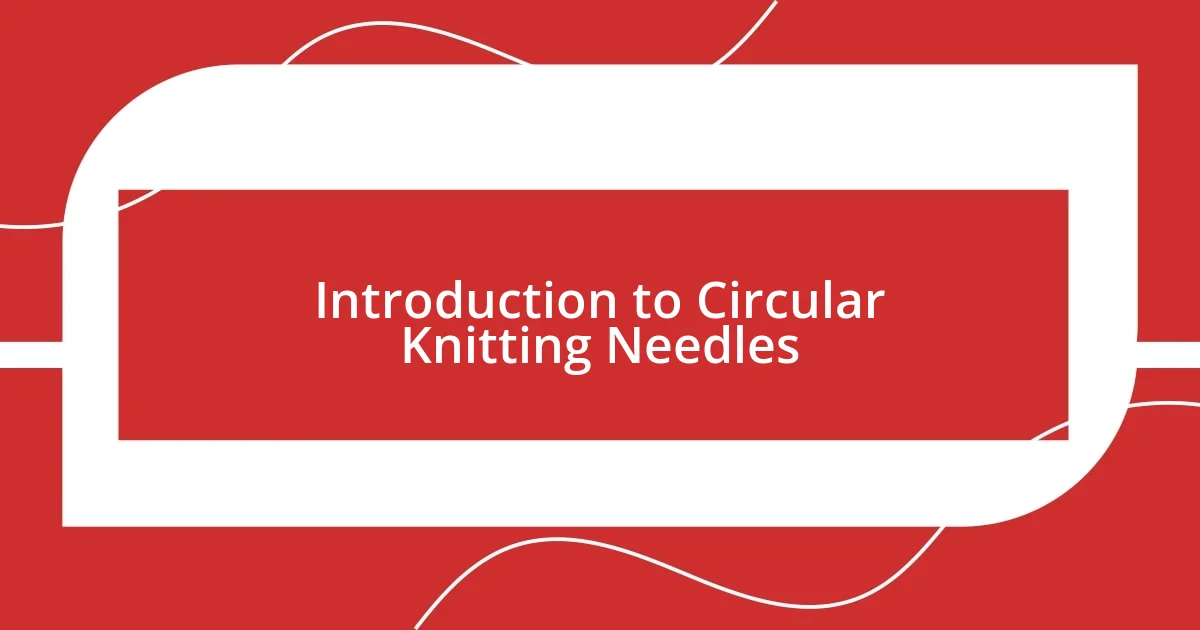Key takeaways:
- Circular knitting needles enhance comfort and versatility, making them ideal for various projects while reducing hand strain.
- Understanding different types of circular needles, including fixed vs. interchangeable and material choices, can greatly affect your knitting experience.
- Maintaining proper care and organization of circular needles is essential for ensuring longevity and a smooth knitting process.

Introduction to Circular Knitting Needles
Circular knitting needles, a favorite among many knitters, are not just tools; they open up a world of possibilities in creating beautiful garments and projects. I remember my first experience with them; the ease of knitting in the round felt like a revelation. Have you ever thought about how they can alleviate the discomfort often caused by straight needles?
What I find fascinating about circular needles is their versatility. They’re ideal for a variety of knitting techniques, from simple scarves to intricate sweaters. Using a longer cable, I’ve comfortably tackled larger projects without the usual struggles of managing multiple straight needles. Doesn’t it just make you want to dive into your yarn stash?
Moreover, their design allows for seamless knitting, meaning fewer seams to sew up at the end, which I truly appreciate. This practicality resonates with many knitters I’ve talked to; it’s like having an extended embrace of your project without interruptions. Isn’t it exciting to think about how circular needles can transform your knitting journey?

Benefits of Using Circular Needles
Using circular needles definitely brings a unique flow to the knitting process. One significant advantage I’ve found is how comfortable they make knitting, especially for extended periods. I remember getting lost in crafting a beautiful blanket, and the circular needles helped me avoid hand fatigue that often comes with traditional straight needles. It felt almost restorative, like sipping a warm cup of tea while enjoying my favorite hobby.
Here are some standout benefits of using circular needles:
- Versatility: Ideal for a range of projects—small or large.
- Comfort: Reduces strain on hands and wrists, allowing for longer knitting sessions.
- Space-Saving: The needle and cable are compact, making them easier to manage.
- Fewer Seams: Perfect for seamless knitting, reducing finishing work.
- Multitude of Techniques: Great for various methods like magic loop or knitting two at a time.
I love how they not only enhance my technique but also make the whole experience more enjoyable. It’s like the difference between riding a bike with training wheels and riding it freely; I feel more liberated in my creativity.

Types of Circular Knitting Needles
When exploring the various types of circular knitting needles, it’s important to highlight the key differences among them. One of the primary distinctions is between fixed and interchangeable needles. I remember my initial confusion over which type to choose. Fixed needles are great for consistency, as they come with a set cable length and needle size, making them straightforward to use for specific projects. Alternatively, interchangeable needles offer remarkable flexibility; you can mix and match cables and tips for different projects, turning your knitting into an adventure of choices!
Another aspect to consider is the material of the needles. Metal needles glide effortlessly, which I find delightful when I’m on a roll with a complicated pattern. I can lose track of time, allowing the yarn to flow as I create. On the other hand, bamboo needles provide more grip, which is especially helpful for slippery yarns. I distinctly remember a time when I struggled with a silk blend that kept slipping off my metal tips, leading to a cascade of stitches falling—not a fun experience! Each material serves a unique purpose, catering to different knitting styles and preferences.
Lastly, the length of the cable can impact your knitting experience as well. Shorter cables are excellent for smaller projects, like hats or sleeves, where the stitches bunch together beautifully. Conversely, longer cables work wonders for larger pieces, such as blankets or shawls. I often switch it up based on the project, making sure I have just the right length on hand for seamless transitions. Understanding these types can significantly enhance your knitting journey and elevate the joy of creating.
| Type | Description |
|---|---|
| Fixed Needles | Pre-attached tips and cables, best for specific projects. |
| Interchangeable Needles | Mix and match cable lengths and needle sizes, offering flexibility. |
| Material: Metal | Allows yarn to slide easily; great for complex patterns. |
| Material: Bamboo | Provides more grip, ideal for slippery yarns. |
| Cable Length: Short | Perfect for small projects with stitches packed closely. |
| Cable Length: Long | Best for larger projects, allowing for more stitches. |

Choosing the Right Needle Size
Choosing the right needle size can feel overwhelming, especially with so many options available. I once found myself staring at a wall of needle sizes in my local craft store, questioning whether to go with a larger or smaller size. Typically, I use the yarn label as my guide—it often specifies the best needle size to achieve the intended gauge. Remember, gauge is crucial for ensuring that your finished piece fits as expected.
I’ve learned that experimenting with needle sizes can also lead to some delightful surprises. I once opted for a smaller needle size than recommended for a scarf project, thinking it would add a tighter texture. What I discovered was an unexpected coziness that made the scarf feel like a warm hug. It taught me that sometimes, the best creations come from a little trial and error. Have you ever taken a leap of faith with your knitting, only to be rewarded with something beautiful?
Moreover, the impact of needle size on your tension can’t be understated. I remember a time when I knitted a sweater using a larger needle, which resulted in a more relaxed stitch—perfect for that breezy, casual look I was after. If your goal is a structured, tailored garment, opt for a smaller size to achieve that desired snugness. I find that understanding this balance not only enhances my knitting but also connects me closer to my projects, making each stitch feel intentional.

Techniques for Using Circular Needles
Using circular needles can open a world of creativity, especially when it comes to mastering various techniques. One technique that I often find myself using is the magic loop method, which is fantastic for knitting small circumferences like socks. It involves pulling a long loop of cable through your stitches, giving you the flexibility to work in the round with ease. The first time I tried it, I was amazed at how it transformed my approach to smaller projects. Have you ever felt that frustration of struggling with tiny dpns? The magic loop truly changed my knitting game!
Another technique worth exploring is the two-at-a-time method, perfect for those who want to knit matching items, like a pair of socks or mittens. I recall the excitement I felt when I completed my first pair this way—it was thrilling to see two identical pieces coming together simultaneously, cutting my finish time in half! Taking on two projects at once might seem daunting, but it adds a fun challenge that keeps things fresh. Have you ever wished you could just double the joy of your knitting without doubling the effort?
Lastly, I’ve found that learning to maintain consistent tension while using circular needles is crucial. It took me a little while to develop a rhythm, but as I practiced, my stitches began to look more uniform and professional. I remember having a moment of realization when I finished a project that felt smooth and nicely textured; it was like uncovering a hidden talent! If you’re grappling with tension issues, don’t hesitate to play around and see what feels most natural to you—knitting, after all, should be an enjoyable journey of self-expression.

Common Mistakes to Avoid
When venturing into circular knitting, one common mistake is not paying attention to the stitch count when transitioning from straight to circular needles. I remember my first time attempting to knit a large blanket in the round. Excitedly, I cast on only to realize, mid-project, that my stitch count was dramatically off—what a frustrating surprise that was! Keeping your stitch count consistent is key; it ensures your work remains even and avoids the headache of unraveling later.
Another pitfall I often see—especially in my own early knitting attempts—is neglecting to secure the cable properly before starting to knit. There was a time when I started a project, only to find the cable twisted and my stitches skewed halfway through. It was a learning moment for me! Taking a few seconds to ensure the cable is straight not only saves time but also greatly contributes to a smooth workflow.
Lastly, I think many knitters underestimate the importance of choosing the right yarn for circular needles. I once picked a fuzzier yarn for a project and found it snagged constantly on the needles. The frustration was real, and I often found myself distracted from what should have been an enjoyable process. It’s worth considering the texture and weight of your yarn; finding the right match can elevate your project and make all the difference in your knitting experience.

Care and Maintenance Tips
To keep your circular knitting needles in prime condition, I recommend wiping them down after each use. This simple act can prevent any buildup of oils or lint from your hands or yarn. I recall a time when I neglected this step after a particularly intense project, only to find my needles becoming a bit sticky. Since then, I’ve made it a habit to give them a quick clean, and it makes a noticeable difference!
It’s also vital to store your circular needles properly. I used to toss mine into a drawer, which led to all sorts of tangled cables and bent tips. Now, I keep them organized in a needle case. Not only does it protect them, but it also saves me time when I’m searching for the right size. Have you ever felt the stress of a disorganized workspace while knitting? Finding those needles easily can make the experience much more enjoyable!
Finally, always be gentle with your cables—after all, they’re the backbone of your circular needles. I remember once yanking on a cable too hard, which resulted in a painful break during a project I loved. From that moment on, I learned to handle them with care, ensuring that my cables are flexible and free from tension when I’m knitting. It’s all about being mindful, right? Those little mindfulness moments can extend the life of your favorite tools!














